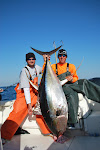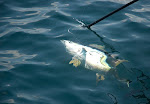| |
|
Contact: Kim Amendola FOR IMMEDIATE RELEASE 727-551-5707 April 19, 2011
NOAA: All Federal waters of the Gulf once closed to fishing due to spill now open More than 1,000 square miles opened today
NOAA today reopened to commercial and recreational fishing 1,041 square miles of Gulf waters immediately surrounding the Deepwater Horizon wellhead, just east of Louisiana. This is the twelfth and final reopening in federal waters since July 22, and opens all of the areas in Federal waters formerly closed to fishing due to the Deepwater Horizon oil spill.
This reopening was announced after consultation with the U.S. Food and Drug Administration and under a reopening protocol agreed to by NOAA, the FDA, and the Gulf states.
“I am pleased to announce that all federal waters affected by the spill are now open to all fishing,” said Jane Lubchenco, Ph.D., under secretary of commerce for oceans and atmosphere and NOAA Administrator. “I thank fishermen and the public for their patience and FDA for its support and cooperation throughout this process while we worked diligently to ensure the integrity of Gulf seafood.”
NOAA sampled this area between November 11 and November 14, 2010, March 12 and March 16, 2011, and March 28 and April 1, 2011, for potentially affected finfish, including tuna, swordfish, and escolar. Sensory analyses of 86 finfish samples and chemical analyses of 112 finfish samples in eight composites followed the methodology and procedures in the reopening protocol, with sensory analysis finding no detectable oil or dispersant odors or flavors, and results of chemical analysis for oil-related compounds and dispersants well below the levels of concern. All test results are publicly available.
As announced on October 29, NOAA and FDA developed and implemented a chemical test to detect the presence of dispersants in fish, oysters, crabs and shrimp. The level of concern for dispersants is 100 parts per million for finfish and 500 parts per million for shrimp. The test can reliably detect Dioctyl sodium sulfosuccinate (DOSS) at levels of 2000 times below the lowest level of concern. The results of chemical testing showed that 99 percent of samples contained no detectable dispersant residues, and the few samples that did contain dispersant residues showed levels more than 1000 times lower than FDA levels of concern.
“Throughout this process, public health and safety has been our primary goal,” said FDA Commissioner Margaret A. Hamburg, M.D. “This has been an extraordinary team effort and the reopening of these federal waters serves as a dramatic example of what cooperation between federal agencies can accomplish.”
NOAA continues to work closely with the FDA and the Gulf states to ensure seafood safety. Thousands of test results, all publicly available, prove Gulf seafood is safe from oil and dispersant contamination.
The total area reopened today is about 0.4 percent of federal waters in the Gulf of Mexico and 100 percent of the formerly closed area, as last modified on February 2, 2011. No oil or sheen has been documented in the area since August 4. At its peak, the closed area was 88,522 square miles, or 37 percent of Federal waters in the Gulf of Mexico.
NOAA’s mission is to understand and predict changes in the Earth's environment, from the depths of the ocean to the surface of the sun, and to conserve and manage our coastal and marine resources. Find us on Facebook.
On the Web: History of federal reopenings in the Gulf: http://sero.nmfs.noaa.gov/BPOilSpillArchives.htm
– 30 –
|
Wednesday, April 20, 2011
Deepwater Anniversary.... Please remember the lost, brave men!!
Thursday, April 14, 2011
Venice Louisiana Deep Sea Fishing "Summer 2011"
April 2011 marks the one year anniversary of the BP “Deepwater Horizon” Oil Spill. Many avid fishing enthusiasts are wondering what the effects have been in the area they frequent several times a year for charter fishing. Venice, Louisiana is located so close to the deep water canyons of the Gulf of Mexico making the sport fishing opportunities world class. Venice is home to several major IGFA sport fishing tournaments each year. In the world of on-camera fishing personalities; anyone, who is someone, films a television show in Venice which airs to millions of viewers. Captain Mike Gray, Cajun Odysea Charters, located in Venice says “the fishing is better than ever.” Captain Mike reports that limits of yellowfin tuna are being caught, the mahi-mahi are already showing up and “YES” huge blue marlin are being caught. Populations of reef fish including red snapper, amberjack and grouper are abundant. June marks the opening of some reef specie seasons and Gray says “the snapper and grouper are so thick limits can be caught in just minutes.” One of the reasons for the increased catch in Venice can be explained by Dr. Russell Chianelli who is a professor at UT and says “There are organisms that eat oil called Hydrocarbon Degraders”… “These organisms consume oil creating CO2 and H2O and more of themselves. Approximately, 50% of the petroleum goes to making biomass and then goes up the food chain.” Gray, who runs a charter business in Venice, Louisiana, www.CajunOdysea.com supports Dr. Chianelli’s theory stating, “We have seen an increase in bait fish, which in turn has brought more game fish.” Until I heard this theory, I had no explanation for the incredible fishing. I thought since the Gulf of Mexico had some closed areas last year during the “Deepwater Horizon” accident that the lack of fishing pressure had increased the number of fish. However, as the fishing continued to get better and better I questioned my original theory. As we took customers into the Gulf to target Yellow Fin Tuna I was seeing more and more bait. I have recently witnessed things in the Gulf I have never seen including bait pods the size of football fields and millions of bait fish that are only seen occasionally in our area. Additionally, Dr. Russell Chianelli says “After every major oil spill there is an explosion in the number of fish and other marine creatures as they consume the Hydrocarbon Degraders. Everywhere in the ocean oil seeps occur. In fact, many of the deposits in the Gulf of Mexico were discovered by observing Oil Seeps.” Venice, Louisiana is located 70 miles south of New Orleans which makes adding a charter fishing trip a definite possibility if you are traveling to “The Big Easy” this summer. Captain Mike Gray says “Catches of Yellowfin Tuna can be caught offshore along with Red Snapper, Amberjack and Grouper.” Trips depart daily from Venice Marina returning late in the afternoon. Your catch is filleted, bagged and loaded in your cooler for transport. Heck, you can be back in the Crescent city for dinner if you choose.
Friday, April 1, 2011
Venice Louisiana Offshore Tuna Fishing Charters
Summer outlook 2011 for Venice Louisiana Yellowfin Tuna fishing in Venice Louisiana has been nothing less than incredible. Check out the pictures on http://www.cajunodysea.com/ and see for yourself. If you have time read the new testimonials, they speak volumes about the incredible fishery in Venice. The fall of 2010 brought the largest push of Jumboz behind the shrimp boats that we have ever seen. Then the hardcore winter months we struggled a little due to high winds and big seas. But ole man winter let loose to a beautiful spring early on in February and the fishing has been stellar. Because the fishing has been so incredibly consistent since the oil spill it is my prediction that the summer of 2011 in Venice will go down in the history books as possibly one of the best years of fishing anyone can remember. If you have been planning a trip to Venice Louisiana this is the year to "Run, Don't walk".. Make plans now, choose a reputible guide and head south to lower plaquemine parrish. Best- Captain Mike Gray http://www.cajunodysea.com/
Subscribe to:
Posts (Atom)





